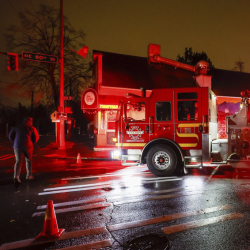|
|
STERLING HEIGHTS, Mich. (AP) -- Fitzpatrick Manufacturing Co. is a high-tech job shop, crafting super-precise parts for machines used in everything from robotics to aerospace to oil exploration. Macomb Community College lies a few miles down the road in this Detroit suburb.
Sometimes it's hard to tell where one ends and the other begins.
Fitzpatrick's 93 employees are constantly in and out of Macomb, taking classes with a tuition reimbursement from the company. And so frequently are Macomb instructors at Fitzpatrick's plant to offer lessons on the esoteric technology used there that the company built a classroom, now lined with about 250 diplomas and certificates employees have earned. Company president Kevin LaComb describes the school as concierge-style job training - exactly what his workers need to keep a quality advantage over lower-cost competitors overseas.
"You tell them what you need, pretty much in a couple days, they have an instructor," he said. "Other people say, `This is what we're offering, but we can't deviate from what we do.' Macomb customizes just what we need."
Community colleges, long the under-loved stepchildren of American higher education, still don't get the dollars of their four-year counterparts, but they're standing very much in the spotlight these days. President Barack Obama made them the focus last week when he unveiled his proposed budget, which took place at a Northern Virginia community college he's now visited four times. The president joked he'd been to campus so often that he's only three credits shy of graduating.
Why all the attention? One reason is that so-called "middle skill" jobs at places like Fitzpatrick - requiring more than high school but less than a full college degree- look like the most promising source of fuel for quickly revving up an economic recovery. Federal data show they account for roughly half of all jobs, and even when unemployment was over 10 percent nationally last year, a survey conducted by the Manufacturing Institute found that two-thirds of manufacturing companies reported moderate-to-severe shortages of qualified workers to hire. That kind of training is the sweet spot for the country's 1,167 community colleges.
But the other big reason is speed and agility. Compared to more slow-to-respond sectors of higher education, community colleges have become more entrepreneurial, flexible and responsive. Here in the Detroit area and around the country, many have mastered the art of staying on top of rapidly churning technologies and quickly piecing together curricula in fields just being born.
Most teachers aren't tenured professors but professionals plucked from changing fields. If community colleges don't have someone on staff to teach a class, they hire an adjunct. And they can move in weeks or sometimes days, earning a reputation as the only corner of higher education that really operates at private sector speeds.
In Michigan, where unemployment peaked at 14.1 percent in 2009 but has since fallen to 9.3 percent, leaders hope the agility of community colleges will accelerate a manufacturing rebound. Money is tight, but one program offers free training for companies filling newly created jobs. In return, state income taxes generated by the new positions kick back to the school for two years, and then to the state. Organizers of the program, modeled on something similar in Iowa, say it's supported 8,000 new jobs and easily pays for itself. They're trying to get a $50 million cap lifted so they can move down the waiting list of companies that want to participate.
Many Michigan students moving through such programs used to work at companies most Americans have heard of: Electrolux, Alcoa, Whirlpool, and of course the Big Three automakers and the companies that supported them. The companies where they're now training for jobs are less well-known: BioDri (alternative energy), Trans-Matic (metal stampings), Oxus America (oxygen concentrators). Typically, such companies are younger and smaller and need tightly tailored training that applies only to themselves or a very narrow industry sector.
"For small- and mid-size employers who actually generate a lot of the jobs in this economy, developing that kind of training for 5 or 10 employees that they're going to hire, it's not economically feasible," said Rachel Unruh, associate director of the National Skills Coalition, a foundation-supported workforce development coalition. That's where community colleges come in.
On the factory floor at Fitzpatrick Manufacturing, $100,000 machines do work that used to be cranked by hand - but somebody has to know how to run the machines. Software evolves constantly, as do the machines customers are building with these parts. For some parts, the margin of error can be no more than .0004 inches - roughly one-tenth the width of a human hair.
One typical "middle skill" is called "geometric dimensioning and tolerancing," or GDT. Basically, it's a language of symbols used in engineering blueprints. Customers used to give companies like Fitzpatrick blueprints with written words, but that left too much room for error. Now the field has shifted to GDT as a kind of lingua franca. On two recent Saturdays, Macomb instructors came by to help employees brush up on GDT.
"To learn calculus that you would learn in an engineering curriculum is all well and good," said Mike Fitzpatrick, whose family founded the company in 1952 and who sold it to LaComb and a partner last year but remains on staff. "But it has nothing to do with us."
Large companies are no less appreciative of rapid response times. When the big Dow Chemical plant in Midland, about two hours north of here, is ready to ramp up production in its chemical processing unit, it calls Patricia Graves at nearby Delta College, who in turn starts calling a list of interested students to ask, "When can you start?"
Soon, another "Fast Start" customized training program in chemical process operations is up and running at Delta. Sixteen weeks later, virtually all graduates move on to work for Dow Chemical or one of the other major plants in the region. Some return to Delta after they start work for even more customized training. Delta has trained and placed eight such groups of roughly 20 people each. Now it offers versions serving other Dow operations in the area, including a six-week program for solar manufacturing and a 10-week program in batteries.
When the call comes "we'd like six weeks" lead time to get a new class running, said Graves, Delta's executive director of corporate services. "We can do it in four. We've actually done it in two."
Certainly community colleges have shortcomings and challenges, namely high failure rates for students who intend eventually to earn a degree.
Community colleges say that's to be expected given the wide mission they're asked to perform, and the fact that they receive just 27 percent of total public dollars spent on public higher education but serve 43 percent of students, according to the American Association of Community Colleges. Enrollments have risen more than a quarter over the last decade, yet tuition has held relatively steady even as costs have soared at four-year colleges. For the average enrolled student, community college is basically free when you factor in grants and aid, according to the College Board.
But criticisms about bureaucracy and lack of success in community colleges are usually directed at for-credit programs and degrees. Non-credit programs, which serve an estimated 5 million out of 13 million community college students nationally, often have a very different, more entrepreneurial feel. Such instruction doesn't have to please curriculum committees and state boards, just local employers and employees. And often what they want is speed.
"On the non-credit side, there's much more flexibility," said Mike Hansen, president of the Michigan Community College Association. "There's much less of an approval process, and the structures of the colleges tend to be me much leaner."
In his budget unveiled last week, Obama asked Congress to create an $8 billion fund to help community colleges train up to 2 million workers for jobs in high-growth fields, and to award financial incentives to make sure trainees find permanent work. There were few other details about how the proposal might work, and it faces long odds in Congress.
Thomas Bailey, director of the Community College Research Center at Teachers College, Columbia University, said he believes such targeted workforce programs can be successful if well-focused, but there's been little hard research.
One concern: If training is too narrowly tailored to particular companies, and doesn't award credit, workers may be stuck with non-transferable skills if the employer goes under.
Brian Gasiewski, a division leader on the factory floor at Fitzpatrick, doesn't worry much about that. Skills like GDT, he said, are important across the industry.
Gasiewski was previously enrolled in a degree program at Macomb but isn't at the moment due to family and time constraints. He may return someday, but for now says focusing on training targeted to precisely what Fitzpatrick does is the best way to advance his career here.
That looks like a better bet than it might have two years ago, when the company's sales fell by half. In 2011, however, they rebounded to their second highest level ever.
----
Follow Justin Pope at http://www.twitter.com/JustinPopeAP .
© 2012 The Associated Press. All rights reserved. This material may not be published, broadcast, rewritten or redistributed. Learn more about our Privacy Policy and Terms of Use.





















































































































































































































































































































































